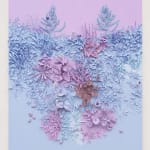Michael Assifff
159.1 x 123.2 x 21.6 cm
Further images
In 1982, Pierre Keller–the former artistic director of the historic Montreux Jazz Festival in Lake Geneva–met the young artist Keith Haring. Earlier in the year, Keller began the “carte blanche” initiative, commissioning Jean Tinguely to be the first artist to produce posters for the festival. Keller then asked Haring to create posters for the 17th edition of the festival and subsequently invited Haring to come to Montreux for the Festival, held in July of 1983. During his time in Lake Geneva, Haring painted local streets and created t-shirts with his designs for the festival. The present monumental work is an anthology of Haring’s most iconic images: slinky dancing figures, the radiant baby, the family dog and the TV atom symbol, which Haring painted that summer on eight white panels affixed to a building under construction on Rue du Théâtre, across the street from the festival’s venue, the Casino de Montreux.
His 1983 visit was the first of several trips to Switzerland during the eighties, including his return to the festival in 1986 with Andy Warhol. Haring not only enjoyed the music scene of the jazz festival but also became immersed in the nightlife in Switzerland. The music festival, founded by Claude Nobs in 1967, quickly became an iconic destination for the visual arts under the guidance of Keller. The honor to produce the “carte blanche” posters for Montreux was extended in future years to other iconic artists such as Andy Warhol and Niki de Saint Phalle. Haring’s 8-panel masterpiece from 1983 testifies to Haring’s personal and professional history with Keller, with whom the work resided until May of 1989. The twisting, barking, and skipping acrobatic figures in Haring’s painting bring to life the joy of movement and music in festival culture. In his journal, Haring once wrote: “My constant association with writers, dancers, actors, musicians etc., forces me to see my intentions/concerns in relation to theirs. They are remarkably similar. I share the same concerns for space and movement and structure as contemporary dancers. I consider spontaneity, improvisations, continuity, and harmony as musicians do.” [1] As the artist noted, some of his most compelling work was born from collaboration and fusion with other artistic media–music and dance chief among them. Having carte blanche to paint and draw for the Montreux festival was an ideal project for an artist like Haring who treasured reaching broad audiences through commercial and public imagery.
The hieroglyphic vocabulary that Haring depicted in the current monumental work and the Montreux posters tell a story of the artist’s stylistic development. The “radiant baby,” visible in the top right corner of the last panel, is an iconic symbol of Haring’s that represents youth, purity, and innocence–further symbolized through the presence of embryonic form in the pregnant figure. The “family dog,” which features several times across the panels, first appeared between 1980 and 1985 in Haring’s subway drawing series. The “family dog” generally represents the abuse of power by authority figures. It is not surprising that beside the most aggressive portrayal of the “family dog” in the fifth panel is a television set with a ringed atom projected inside. Haring’s preoccupation with atomic imagery can be seen throughout his career, but particularly in the early to mid-1980s, at the peak of the anti-nuclear movement. The same TV-atom symbol can be found in his subway paintings from 1983. The range of emotion and expression captured by Haring in the 8 panels is extraordinary–from ecstasy to chaos, oppression, and intimacy. The present work is a paramount work that not only tells the story of the historic Montreux festival and the artist’s collaboration with Pierre Keller, but also the intense creativity that shaped this pivotal stage in Haring’s career.
[1] Keith Haring, Keith Haring Journals (Penguin Books, 2010), p. 132.



